February, 28 2024 ( Updated March, 25 2024)
Along the sparkling coastline of Croatia lies Istria, a captivating peninsula steeped in history, culture, and natural beauty. From ancient Roman ruins to charming hilltop villages, Istria offers a wealth of must-see attractions and hidden gems waiting to be discovered. In this comprehensive Istria itinerary, we have listed the untouched landscapes and vibrant cities of Istria, unveiling its most iconic landmarks and off-the-beaten-path treasures.
Here’s a quick beat!
Explore Coastal Towns: Visit charming coastal towns like Rovinj, Pula, and Poreč with their historic architecture, cobblestone streets, and beautiful seaside views.
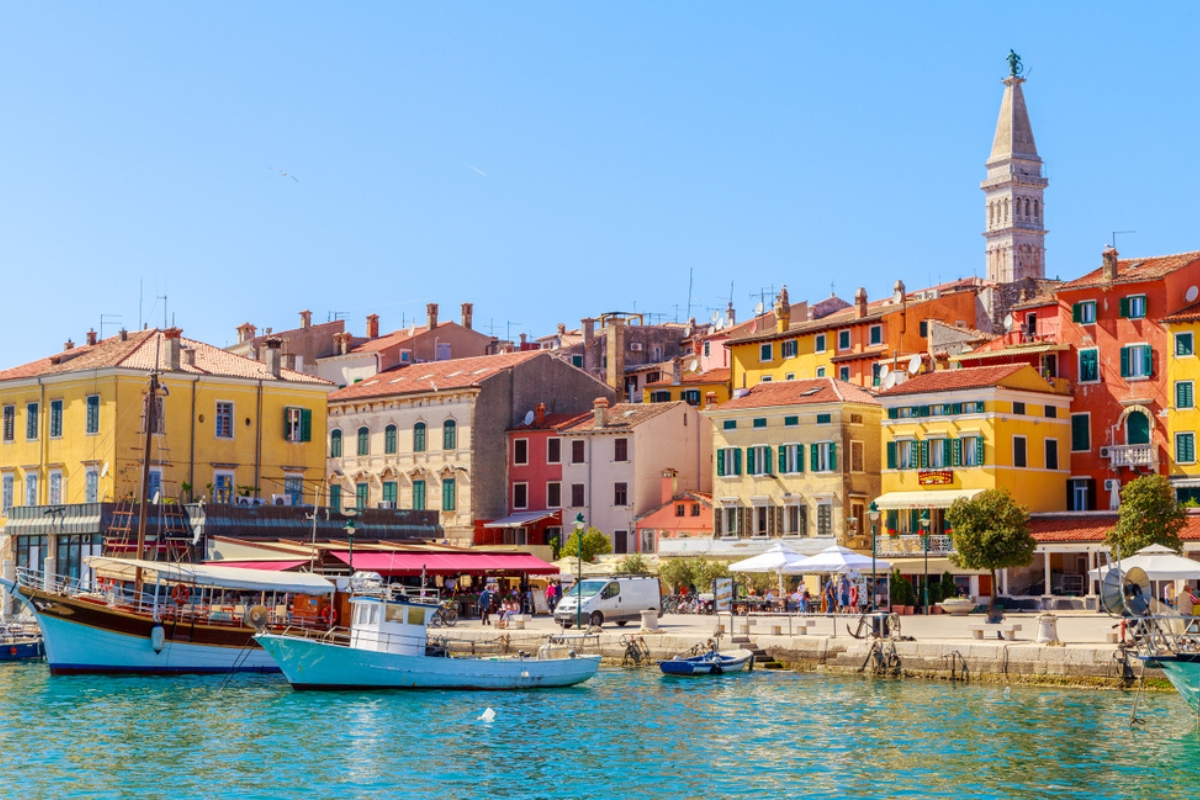 Savour a walk on the colourful Rovinj waterfront
Savour a walk on the colourful Rovinj waterfront
Sample Local Cuisine: Taste Istrian cuisine, known for its fresh seafood, truffles, olive oil, and local wines.
Dive into Cultural Sites: Explore historical sites such as the Roman amphitheater in Pula, Euphrasian Basilica in Poreč, and hilltop towns like Motovun, famous for its medieval architecture, truffle festivals, and stunning views of the surrounding countryside!
Join the force of nature with Outdoor Activities: Enjoy outdoor activities like hiking, cycling, and exploring the natural beauty of Istria's countryside, including its forests, hills, and coastline.
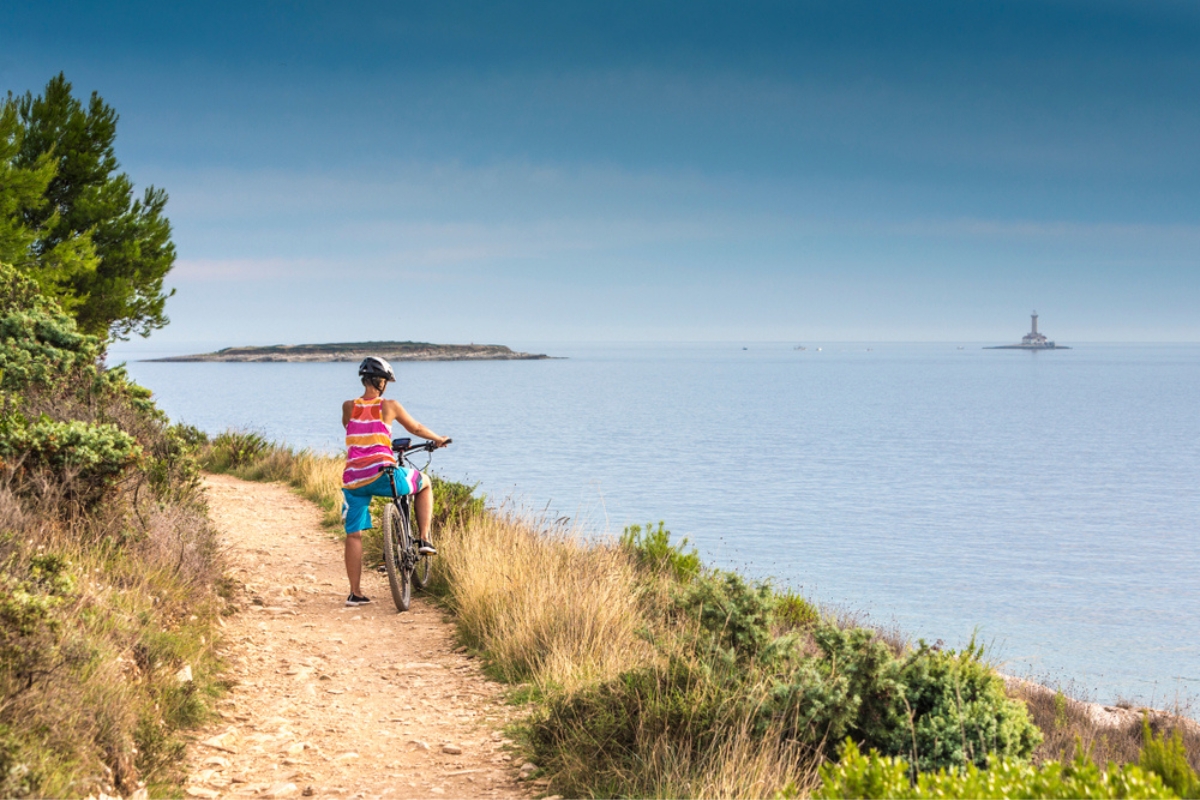 Enjoy the beauty of the coastline by cycling on Cape Kamenjak, near Pula
Enjoy the beauty of the coastline by cycling on Cape Kamenjak, near Pula
Time out at the Beaches: Relax on the beaches along the Istrian coast, which offer crystal-clear waters and scenic views.
As per local recommendations, these are our favourites:
Hit it off at Rovinj: Known for its picturesque old town, colourful houses, vibrant bar culture and romantic atmosphere, Rovinj is the most-visited town on the entire peninsula.
Do as the Romans do at Pula: Home to the well-preserved Roman amphitheater, vibrant markets, and beautiful beaches, Pula is the largest city in Croatia.
Enjoy Poreč and its thrilling water sports: A 2000-year-old town now famous for its UNESCO-listed Euphrasian Basilica, seaside resorts and water sports like jet skiing and windsurfing. Plus, this ancient town has the smallest street in Europe known as Ulica Stjepana Konzula Istranina!
Here’s what sets it apart as a Mediterranean destination:
Truffles: Istria is renowned for its truffles, especially the white truffles found in its forests. Don't miss the truffle-infused dishes, which pair wonderfully with Istrian wines.
Wines: Istria is also known for its wine production, particularly Malvasia and Teran wines. Being one of the major wine regions of Croatia, the variety is large: from light and fruity whites to full-bodied reds and sparkling wines.
 Taste the local produce such as white wines and truffles from Istria
Taste the local produce such as white wines and truffles from Istria
Cultural Heritage: Istria rich cultural heritage carries influences from the Romans, Venetians, Byzantines and other civilizations; towns like Pula and Poreč preserve their original Romanesque buildings, stone streets and gothic palaces.
Beautiful Landscapes: From its coastal towns to inland countryside and small, pristine islands easily accessible from various peninsular ports, Istria offers diverse and breathtaking landscapes.
It’s time for the iconic!
 Aerial view of Roman amphitheater in Pula, UNESCO World Heritage Site
Aerial view of Roman amphitheater in Pula, UNESCO World Heritage Site
This well-preserved Roman amphitheater in Pula is one of Istria's most iconic landmarks. Dating back to the 1st century AD, it is one of the largest surviving Roman arenas in the world and the only one with intact side towers. It also hosts various events and concerts throughout the year. If you want to explore more than the arena, then Pula has other equally well-preserved witnesses of history such as the Temple of Augustus and Arch of Sergii.
Comprising 14 islands off the coast of Istria, Brijuni National Park is a pristine natural paradise with lush vegetation, ancient ruins, and diverse wildlife. Visitors can explore the islands' scenic beauty, archaeological sites, and safari park.
Veli Brijun, the main island, offers historical tours and serene Mediterranean landscapes. Don't miss the dinosaur footprints for the kids! The islands can be easily accessed from the port of Fažana, located near Pula.
The charming old town of Rovinj is a picturesque maze of narrow cobblestone streets, colourful buildings, and romantic seaside promenades. Visitors can explore historic landmarks like St. Euphemia's Basilica and enjoy panoramic views from the town's bell tower. Rovinj also offers pleasant beaches, enjoyable boat excursions, and an intriguing array of shops.
In September, the Rovinj Wine Festival provides a chance to taste numerous Istrian wines.
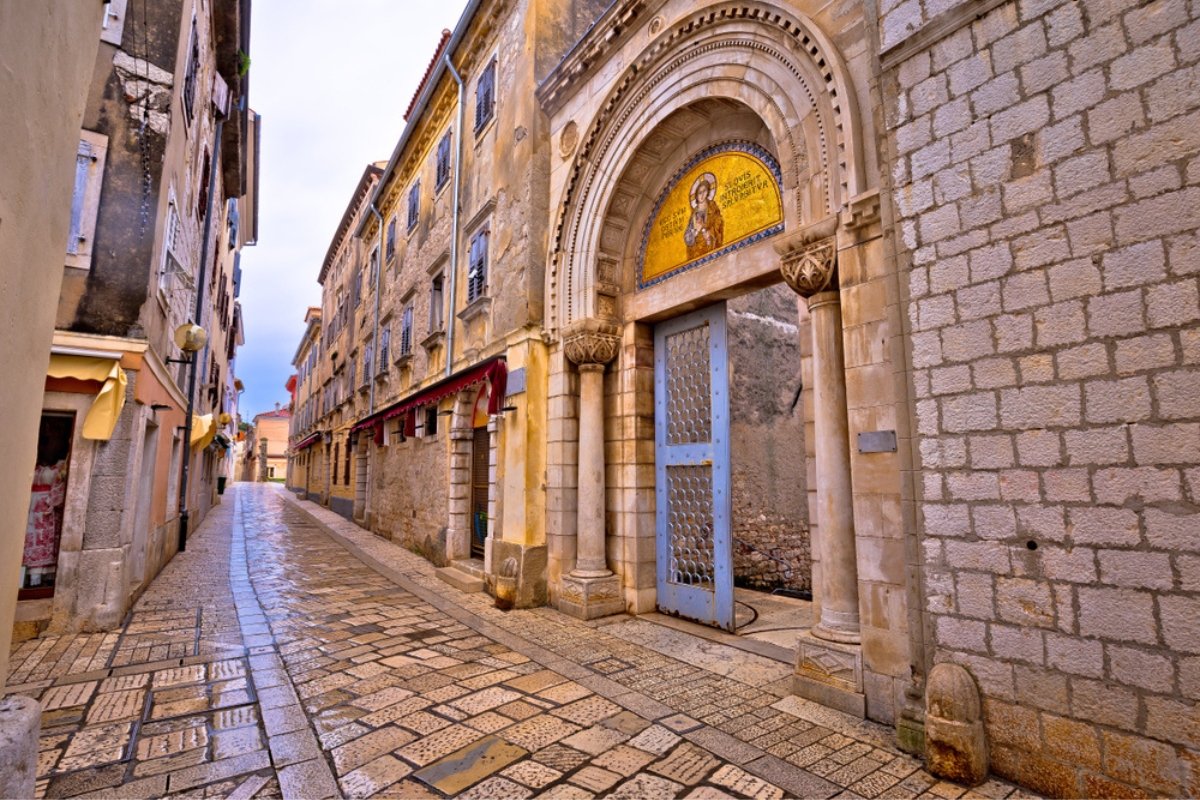 Soak up the old times at the Euphrasian Basilica, UNESCO world heritage site in Istria, Croatia
Soak up the old times at the Euphrasian Basilica, UNESCO world heritage site in Istria, Croatia
A UNESCO World Heritage Site, the Euphrasian Basilica in Poreč is an exquisite example of early Byzantine architecture. Dating back to the 6th century, the basilica features stunning mosaics, marble columns, and a beautiful central dome.
Perched atop a hill overlooking the Mirna River Valley, Motovun is a picturesque medieval town famous for its well-preserved city walls, cobblestone streets, and truffle festivals. Visitors can explore historic landmarks, enjoy panoramic views, and sample local delicacies.
The ascent to the top of Motovun is steep, making it challenging for those with mobility issues. However, the panoramic views at the summit are rewarding. One can also enjoy paragliding off the summit, enjoy lunch with a view of the surrounding hills and explore the city walls. If you visit in late July or early August, don't miss the Motovun Film Festival!
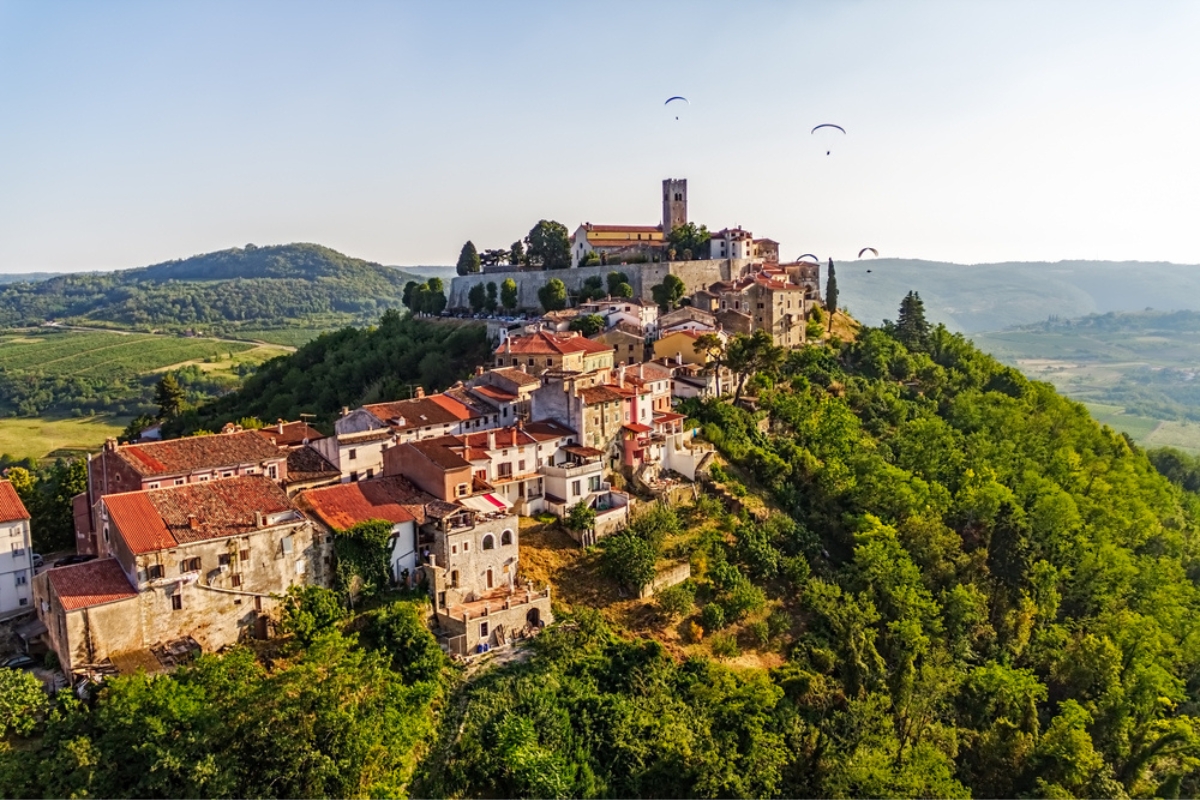 Explore the breathtaking Motovun and enjoy its stunning landscapes
Explore the breathtaking Motovun and enjoy its stunning landscapes
In Motovun, visitors can discover its rich history and stunning landscape through several must-see attractions: Explore the main square and the Church of St. Stephen, central to Motovun's charm and culture. Walk along Motovun's ancient town walls and gates, offering insights into its medieval past and panoramic views of the countryside.
Experience the Parenzana hiking and biking trail, an opportunity to immerse oneself in the scenic beauty of Motovun's surroundings.
Here’s our insider views:
Gračišće
This small hilltop village is often overlooked by tourists but offers charming medieval streets, ancient churches, and stunning panoramic views of the surrounding countryside.
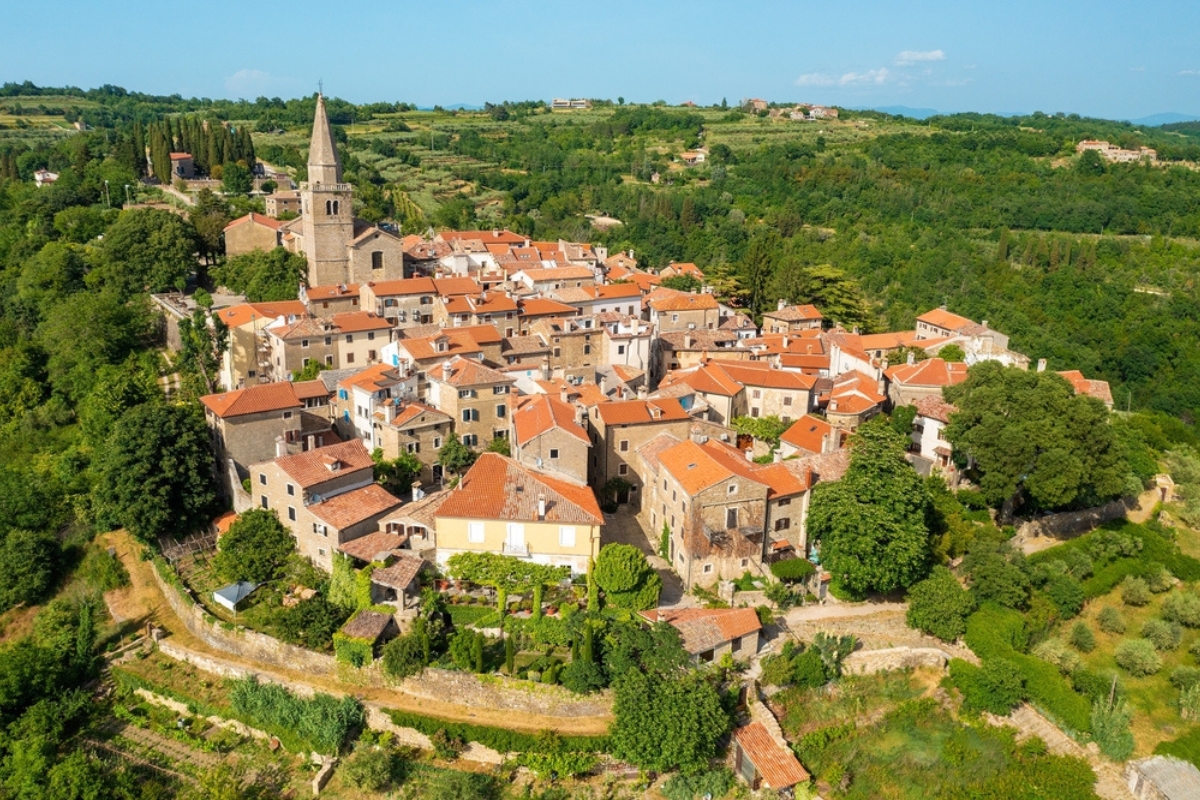 Aerial view of the stunning Grožnjan town in Istria, Croatia
Aerial view of the stunning Grožnjan town in Istria, Croatia
Known as the "Town of Artists," Grožnjan is a picturesque hilltop town famous for its vibrant arts scene, galleries, and cultural events. Visitors can explore its narrow cobblestone streets and discover local artisans at work. In early May, Grožnjan welcomes art and culture enthusiasts with its summer music academies, artistic workshops, and peace activism classes led by renowned experts and teachers.
These offerings include a variety of artistic activities, dance, and drama workshops, attracting visitors interested in enriching their creative skills. Despite its artistic charm, Grožnjan remains a hidden gem, ensuring a serene experience away from large crowds for those who seek cultural immersion.
Lim Bay
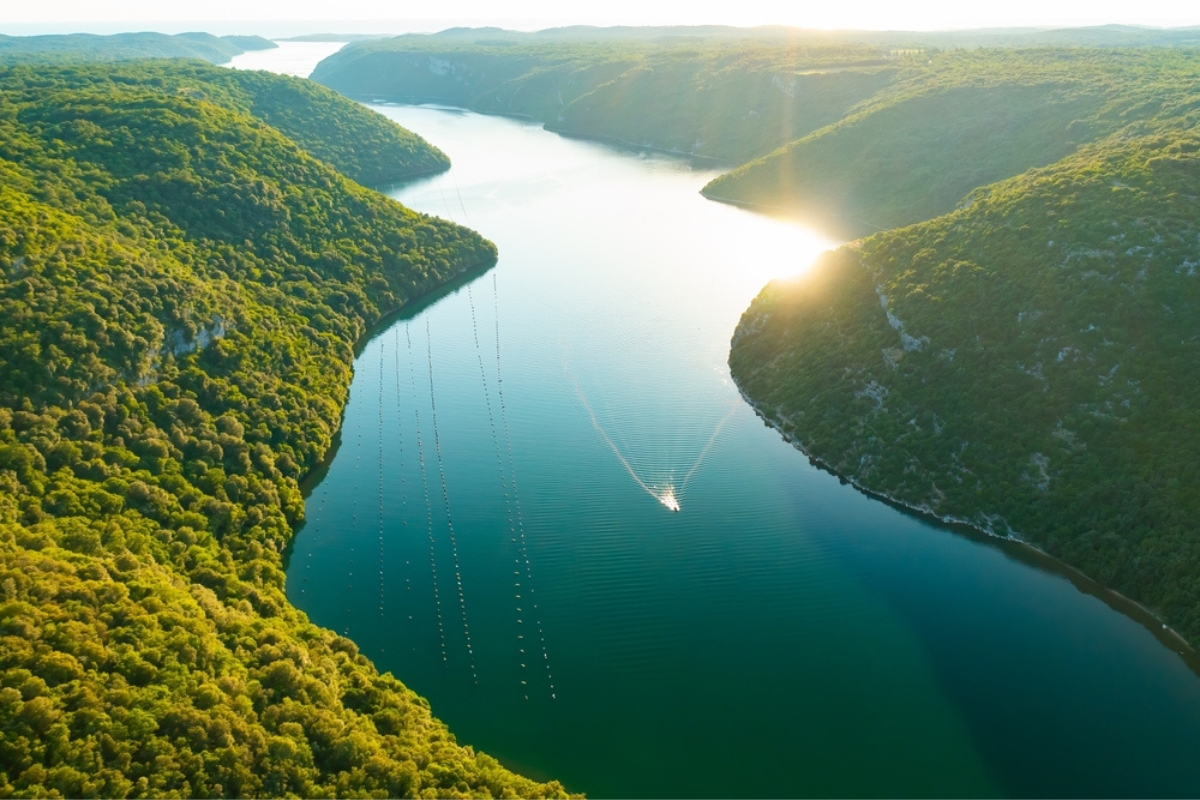 Slow down at the most captivating sites in Croatia, Lim Bay
Slow down at the most captivating sites in Croatia, Lim Bay
A scenic fjord-like bay located between Rovinj and Vrsar, Lim Bay, or Limski Kanal, offers breathtaking views, excellent seafood restaurants, and opportunities for boat tours and kayaking adventures.
Due to its high oxygen concentration, the Bay of Lim fosters abundant plankton, fish, and shellfish production, particularly mussels and oysters. Renowned for its fresh mussels, the Bay of Lim is a culinary delight. Additionally, the Romuald Cave stands as another notable attraction in the area.
If you are lucky, you can even spot dolphins!
Hum
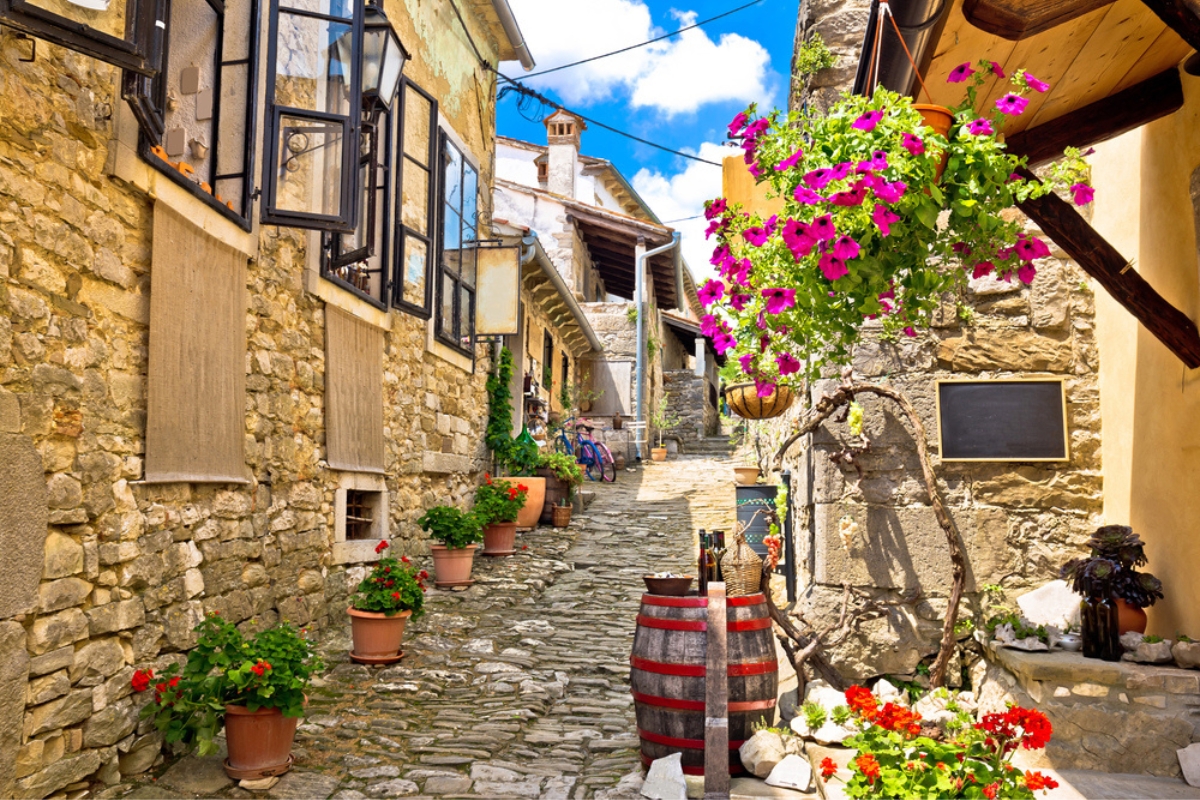 A Colourful street in Hum, the smallest town in the world!
A Colourful street in Hum, the smallest town in the world!
Nestled in hilly countryside 14 kilometers southeast of Buzet, Hum, the world's smallest town with only 17 inhabitants, is a romantic destination boasting several key attractions:
Hum is a hidden gem known for its medieval architecture, stone houses, and rustic charm. Visitors can stroll through its narrow streets and enjoy the peaceful atmosphere.
Tucked away in the interior of Istria, Kotli is a hidden village known for its scenic beauty, old watermill, and natural swimming pools carved out by the Mirna River. It's a perfect spot for nature lovers and outdoor enthusiasts and it’s not even crowded!
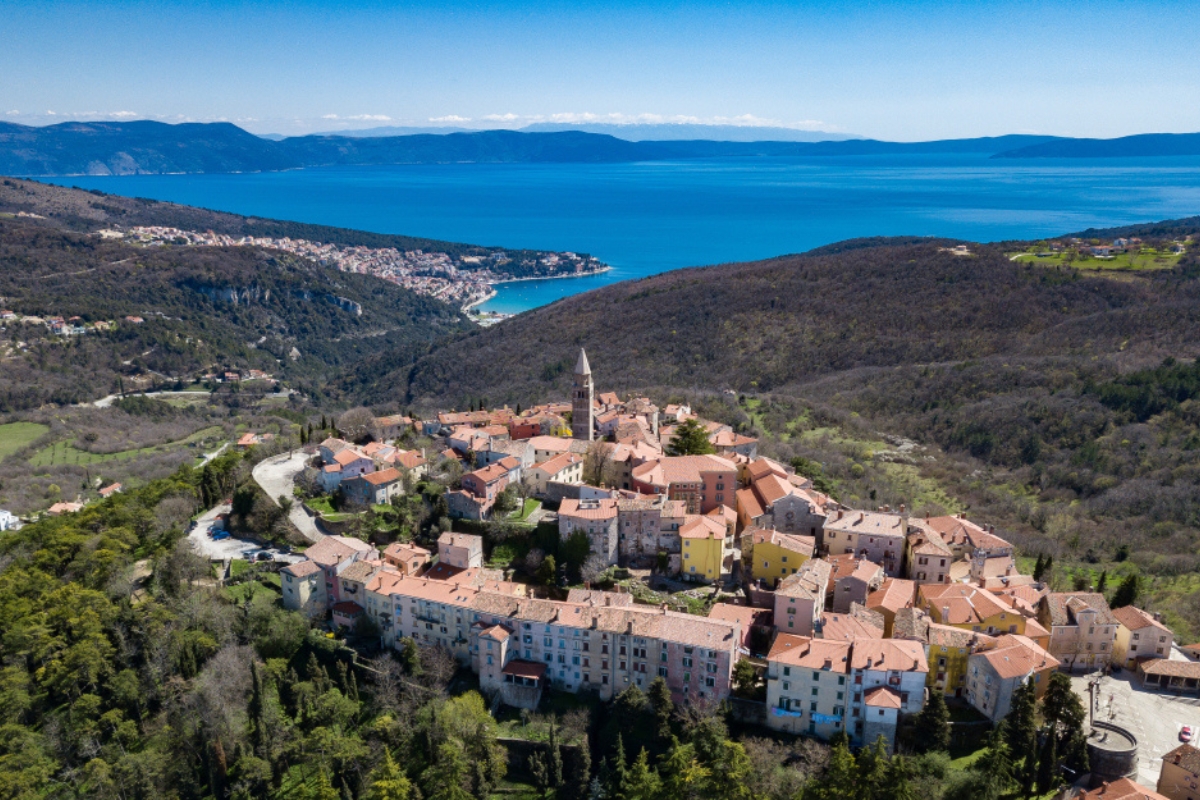 Catch a long view of the Croatian town Labin with a beautiful background featuring the town of Rabac
Catch a long view of the Croatian town Labin with a beautiful background featuring the town of Rabac
Perched on a hill overlooking the Adriatic Sea, Labin is a hidden gem with a rich history, colorful houses, and well-preserved medieval architecture. Visitors can explore its historic old town and enjoy panoramic views from the top.
Labin stands out as one of Istria's most captivating cities, easily reachable and perfect for a day excursion. Don't overlook the opportunity to savour Labinski krafi, a quintessential Istrian dish similar to ravioli, crafted from a delightful blend of cheeses, raisins, lemon zest, rum, and spices. This versatile dish can be enjoyed as both a main course and dessert.
Labin is split into two sections: the Old Town, featuring winding cobblestone streets perched atop a hill with views of the Kvarner coast, and the newer area at the hill's base, bustling with shops.
 Zarečki Krov, another one of nature’s miracles in the Istrian County
Zarečki Krov, another one of nature’s miracles in the Istrian County
Despite its underrated status, Pazin, Istria's capital city, offers stunning features and abundant attractions. Take a refreshing dip at Zarečki Krov Waterfall or Pazin Krov Waterfall, where crystalline waters provide a revitalising escape from the summer heat.
Embark on an underground adventure in Pazin Cave, filled with mysterious chambers and winding passages waiting to be explored by intrepid adventurers. Sample the finest Istrian delicacies at "Taste Istria," a premier shop where you can savor the region's delectable flavors, from truffles to olive oil and local wines.
Experience regal splendor at Pazin Castle, a medieval fortress perched on a limestone cliff overlooking the Pazinčica River. Its breathtaking abyss hosts an exciting zip line, attracting thrill-seekers. Wander through its ancient halls and courtyards, where echoes of history linger around every corner.
For nature enthusiasts, hiking to the majestic Butoniga Slap waterfall offers a breathtaking journey through Istria's pristine landscapes.
The ruins of Dvigrad, an abandoned medieval town, fascinate with tales of a haunting past. Ravaged by Venetian fires in the 14th century and plagued by disease, Dvigrad succumbed to abandonment in 1714, yielding to the relentless embrace of nature.
Visiting these ruins, one is struck by the sprawling remnants, offering a glimpse into the history of construction of medieval Croatian cities. Walking through Dvigrad unveils a truly unique experience, as the echoes of its tumultuous past linger amidst the enchanting ruins.
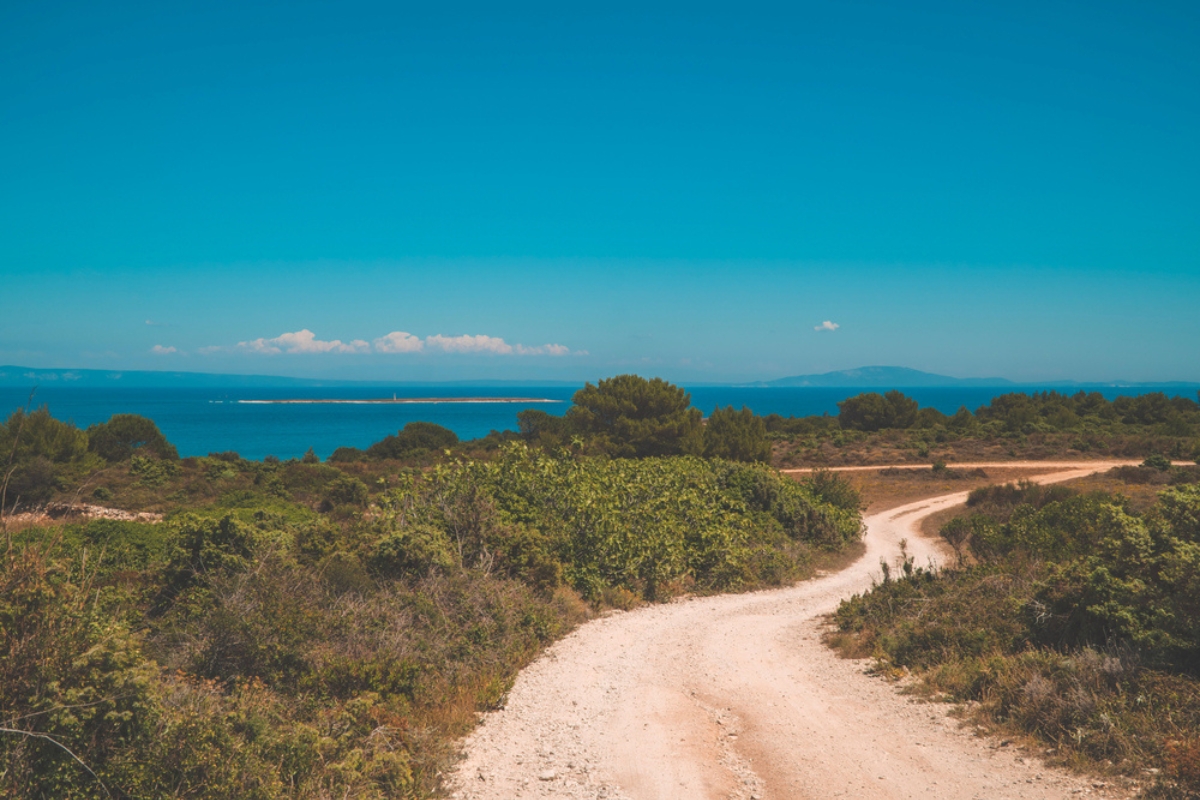 Discover wild landscapes on the coast of Kamenjak National Park in Premantura, Istria, Croatia
Discover wild landscapes on the coast of Kamenjak National Park in Premantura, Istria, Croatia
If you're a nature enthusiast, don't overlook the fun and adventure awaiting you at National Park Kamenjak. Cape Kamenjak is a 10 km (about 6.21 mi) long and 1.5 km wide peninsula. More than just breathtaking landscapes and pristine beaches, Kamenjak offers a host of unique attractions:
Conveniently situated just 10 kilometers from the city of Pula, National Park Kamenjak promises an unforgettable excursion worth adding to your Croatian itinerary.
These hidden gems of Istria offer a glimpse into the region's diverse landscapes, cultural heritage, and natural beauty, providing unforgettable experiences for travellers seeking off-the-beaten-path destinations.
Language: The primary language spoken in Istria is Croatian, although many individuals also speak English. Italian is also quite widespread as Istria used to be part of Italy.
Currency: As of January 1st, 2023, Croatia adopted the Euro (€) as its official currency, replacing the Croatian Kuna. While the Kuna is still accepted in numerous establishments, the Euro is widely used as the main currency.
Type of Travellers: Croatia boasts stunning natural landscapes, historic cities, beautiful beaches, and a rich cultural heritage, making it an ideal destination for travellers of all ages.
Transportation: When navigating Istria, consider renting a car or utilising public transportation, the extensive bus network, indeed, offers convenient transportation options across the region.
Expense: Croatia tends to be more expensive than expected, often compared to Italy, Spain, or Greece rather than Eastern Europe. However, Istria is generally cheaper than popular Dalmatian Coast destinations like Dubrovnik and Hvar.
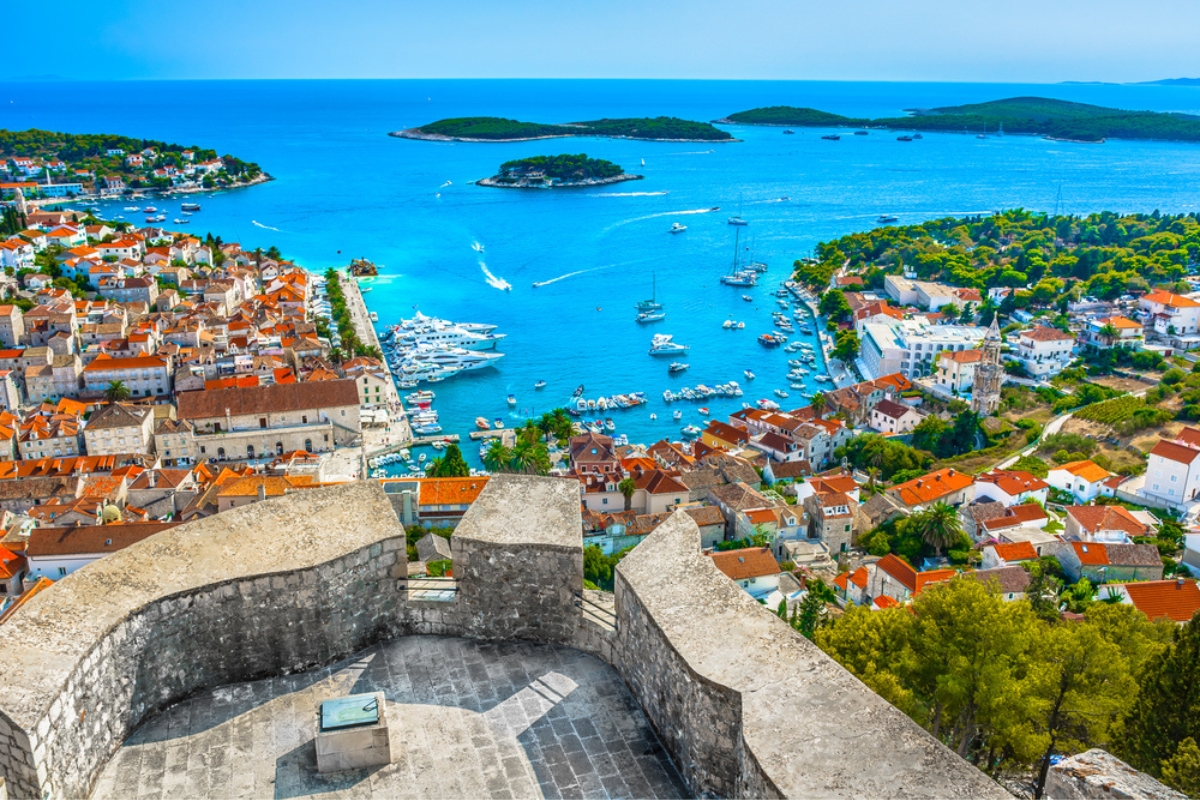 Aerial view at incredible archipelago in front of the town of Hvar, Croatia Mediterranean
Aerial view at incredible archipelago in front of the town of Hvar, Croatia Mediterranean
Best time to visit: Most travellers flock to Croatia, including Istria, during the summer months, driving up prices and visitor numbers. While summer in Istria is delightful, with warm temperatures, it's not as scorching as Dalmatia. In September, the shoulder season, you can still enjoy pleasant weather with fewer crowds as children return to school. Additionally, staying into fall allows you to experience the harvest season, including tasting new wines!
How to reach Istria: From Motovun, you can easily drive to several other popular destinations in Croatia. It's about a three-hour drive to Zagreb, 3.5 hours to the Plitvice Lakes, four hours to Zadar, and five hours to Split, where you can catch ferries to the islands.
Istria is easily reachable by:
So, is it worth going to Istria after all?
Yes, Istria is definitely worth visiting for its stunning coastal scenery, rich history, delicious cuisine, and vibrant culture. Whether you're interested in exploring historical sites, enjoying outdoor activities, or simply relaxing by the sea, Istria has something to offer for every traveller who wants to avoid the big crowds.
Experience Istria this summer. Book now!
join over 80,000 people who receive our updates